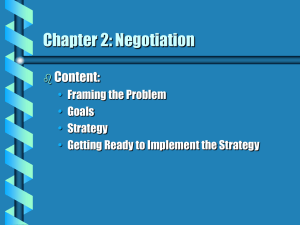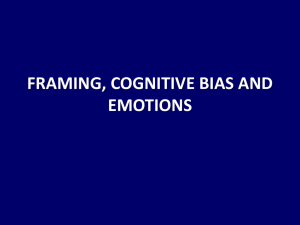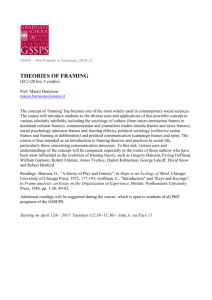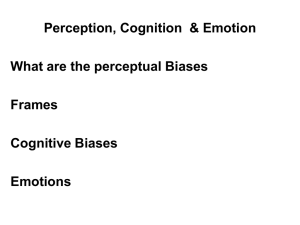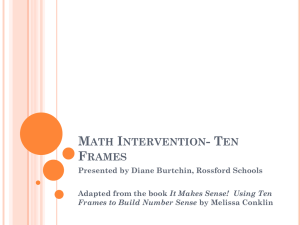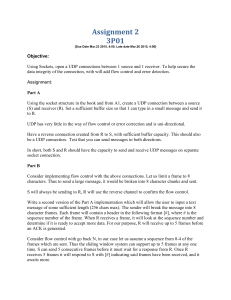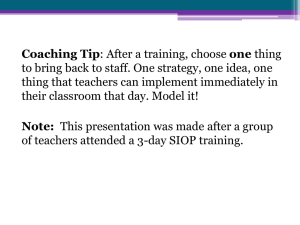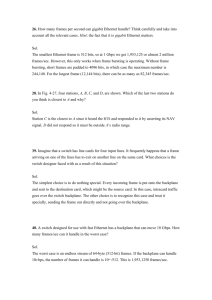Framing, Strategizing, and Planning
advertisement
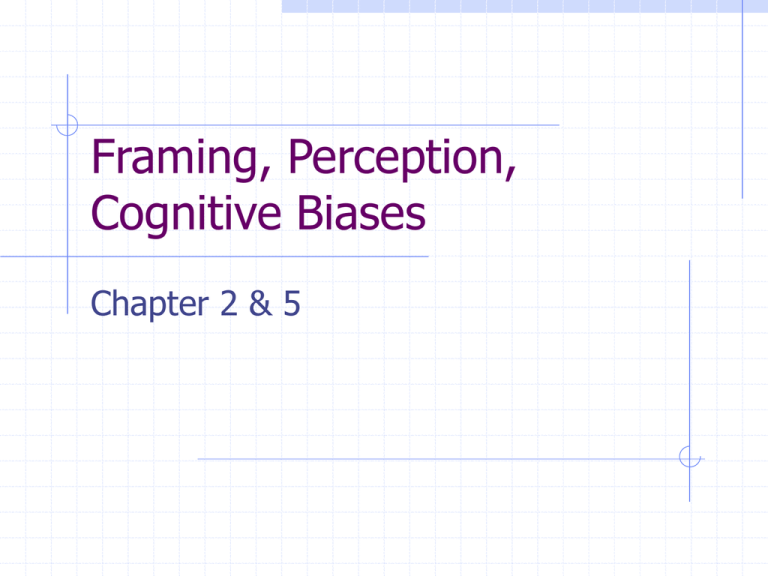
Framing, Perception, Cognitive Biases Chapter 2 & 5 Framing the Problem “Often two or more people who are involved in the same situation see it or define it in different ways.” People use frames to define problems Strong reflection of what they define as critical Expectations and preferences for possible outcomes What info they seek and use Procedures used to present their case Way they evaluate outcomes Frames are inevitable, but changeable Choosing one aspect of a complex situation, ignores other aspects Due to past experiences, attitudes and values, strong emotions Shaped by type of info, setting or context Language Strategies to Facilitate Communication--Reframe Critique…………………… Fight………………………. Debate……………………. The other side……………. Having an argument……. Provocative………………. Most controversial………. Polarize…………………… Automatic opposition……. Win the argument……….. Comment Discussion Discuss Another side Making an argument Thought-provoking Most important Unify Genuine opposition Understand another point of view Understanding Frames Frames As Cognitive Heuristics (mental shortcuts) Set of rules for simplifying complex situations, making decisions. Perceive and shapes outcome Frame tends to persist regardless of events and info that follows. Cognitive biases (ch 5) Advice About Framing Frames shape the key issues. Work to assure your own frames are accepted and acknowledged. When two people’s frames match, they focus on common issues. When not, communication is difficult and incomplete. Negotiators can shift conversation toward the frame they want. Conversations change frames. Negotiators should track changes. Certain frames lead to certain processes and outcomes. Perception and Negotiation The role of perception “Perception is the process of screening, selecting, and interpreting stimuli so that they have meaning to the individual.” Complex environments. Perceptual shortcuts Perceptual errors in negotiation Stereotyping: assign attributes to another solely on basis of other’s membership in a social or demographic group Halo effects: generalize based on one attribute Selective perception: single out certain info to support a prior belief, filters out info that doesn’t confirm Projection: ascribe to others the characteristics of feelings they possess themselves. “No Milk” Homework http://www.viahealth.org/disease/digestive/lactose.htm Stereotyping A distortion of the perceptual process where one individual assigns attributes to another solely on the basis of the other’s membership in a particular social or demographic group. Recognizing differences is NOT necessarily “stereotyping.” More Cognitive Biases Mythical fixed-pie beliefs Ugli Orange Anchoring & adjustment Small movements from a stated point, regardless of reality Winners’ curse Settle quickly, feel bad. Also, buyer’s remorse Overconfidence Law of small numbers Draw conclusions from small sample Self-serving biases “I mess up, it’s bad luck. You mess up, it’s your fault.” Ignoring of others’ cognitions (don’t listen) Reactive devaluation Don’t like you, so don’t value your opinion, even if right Managing Misperceptions and Cognitive Biases in Negotiation Be aware of biases, but hard to change Reframing “Opportunity to gain” rather than “a loss” Perceive situation from different perspective Broader/narrower, bigger/smaller, riskier/less risky Be flexible, invent options How to Improve Communication in Negotiation Use of questions Manageable vs. unmanageable questions (p. 125) “Why not” vs. “why” to unblock negotiations Listening Active listening, reflecting Levels of listening Role reversal Actively arguing the other parties’ position until they are convinced they are understood Goals Determine goals: what you want to achieve Goals, goal priorities, multi-goal packages Agendas, bargaining histories Tangible and intangible Direct effects of goals on choice of strategy Wishes are not goals Our goals often linked to other party’s goals There are boundaries/limits to what goals can be Effective goals must be concrete, specific, measurable. Indirect effects of goals on choice of strategy Strategy The overall plan to achieve one’s goals Strategy, tactics, planning Strategy: long-term, overall approach Tactics: short-term, adaptive moves Planning: action component Strategic options: vehicles for achieving goals Concern for others vs concern for self Substantive outcomes vs relationship Getting Ready to Implement Strategy-- The Planning Process Understanding the need for planning Defining the issues Assembling issues and defining the bargaining mix Defining your interests Consulting with others Knowing your limits Setting targets Developing supporting arguments: research Analyzing the other party Frames Processes of Issue Development Patterns of change that occur as parties communicate How conversation changes the dispute Naming, blaming and claiming Factors shape a frame Bargaining context Conversations Stock issues Best possible case for their preferred position Shifts and transitions in negotiation Multiple agenda items Frames As Categories of Experience Define important, unimportant, expectations, what see or seek. Predispose to pay attention to certain aspects and ignore others Types Substantive Loss-gain Characterization Outcome Aspiration Process Evidentiary



